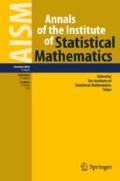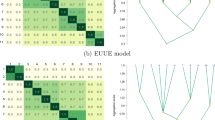Abstract
A new class of local mixture models called local scale mixture models is introduced. This class is particularly suitable for the analysis of mixtures of the exponential distribution. The affine structure revealed by specific asymptotic expansions is the motivation for the construction of these models. They are shown to have very nice statistical properties which are exploited to make inferences in a straightforward way. The effect on inference of a new type of boundaries, called soft boundaries, is analyzed. A simple simulation study shows the applicability of this type of models.
Similar content being viewed by others
References
Amari, S., Nagaoka, H. (2000). Methods of information geometry. American Mathematical Society
Anaya-Izquierdo, K.A. (2006). Statistical and geometrical analysis of local mxiture models and a proposal of some new tests of fit for censored data. PhD Thesis. Universidad Nacional Autónoma de México.
Anaya-Izquierdo, K.A., Marriott, P.K. (2006). Local mixture models of exponential families (Submitted).
Chang H.-Y., Suchindran C.M. (1997). Testing overdispersion in data with censoring using the mixture of exponential families. Communications in Statistics: Theory and Methods 26, 2945–2966
Critchley F., Marriott P. (2004). Data-informed influence analysis. Biometrika 91, 125–140
Darling D.A. (1953). On a class of problems related to the random division of an interval. Annals of Mathematical Statistics 24, 239–253
Embrechts P., Kluppelberg C., Mikosch T. (1997). Modelling extremal events: For insurance and finance. Berlin Heidelberg New York, Springer.
Feller W. (1970). An Introduction to Probability Theory and it Applications. London, Wiley.
Heckman J.J., Robb R., Walker J.R. (1990). Testing the mixture of exponentials hypothesis and estimating the mixing distribution by the method of moments. Journal of the American Statistical Association 85, 582–589
Jaggia S. (1997). Alternative forms of the score test for heterogeneity in a censored exponential model. The Review of Economics and Statistics 79(2): 340–343
Janson S. (1988). Normal convergence by higher order semiinvariants with applications to sums of dependent random variables and random graphs. Annals of Applied Probability 16(1): 305–312
Jewell N.P. (1982). Mixtures of exponential distributions. The Annals of Statistics 10, 479–484
Johnson N.L., Rogers C.A. (1951). The moment problem for unimodal distributions. Annals of Mathematical Statistics 22: 432–439
Jorgensen B. (1997). The theory of dispersion models. London, Chapman & Hall.
Keilson J., Steutel F.W. (1974). Mixtures of distributions, moment inequalities and measures of exponentiality and normality. The Annals of Probability 2, 112–130
Kiefer N.M. (1984). A simple test for heterogeneity in exponential models of duration. Journal of Labor Economics, 3–4, 539–549
Klaassen C.A.J., Mokveld P.J., van Es B. (2000). Squared skewness minus kurtosis bounded by 186/125 for unimodal distributions. Statistics & Probability Letters 50, 131–135
Lindsay, Bruce G. (1989). Moment matrices: applications in mixtures. The Annals of Statistics 17(2): 722–740
Lindsay, B.G. (1995). Mixture models: theory, geometry, and applications. Institute of Mathematical Statistics.
Marriott P. (2002). On the local geometry of mixture models. Biometrika 89(1): 77–93
Marriott P. (2003). On the geometry of measurement error models. Biometrika 90(3): 567–576
McLachlan G.J., Peel D. (2001). Finite mixture models. London, Wiley.
Mosler K., Seidel W. (2001). Testing for Homogeneity in an Exponential Mixture Model. Australian & New Zealand Journal of Statistics 43(2): 231–247
O’Reilly F., Stephens M.A. (1982). Characterizations and goodness-of-fit tests. Journal of the Royal Statistical Society, Series B 44, 353–360
Shaked M. (2003). On mixtures from exponential families. Journal of the Royal Statistical Society, Series B 42: 192–198
Ulrich G., Watson L.T. (1994). Positivity conditions for quartic polynomials. SIAM Journal on Scientific Computing 15(3): 528–544
Wong R. (2001). Asymptotic approximations of integrals (Classics in applied mathematics). Philadelphia, SIAM.
Author information
Authors and Affiliations
Corresponding author
About this article
Cite this article
Anaya-Izquierdo, K.A., Marriott, P.K. Local mixtures of the exponential distribution. AISM 59, 111–134 (2007). https://doi.org/10.1007/s10463-006-0095-z
Received:
Revised:
Published:
Issue Date:
DOI: https://doi.org/10.1007/s10463-006-0095-z




